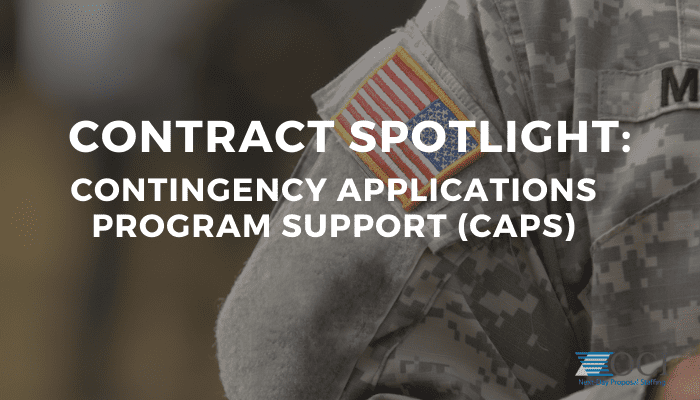CAPS RFP: Are you prepared for the US Army’s DAGRS recompete? – – “Dressed for the Prom” as Contingency Applications Program Support (CAPS)?
What’s the Opportunity for this go-around?
The FY 2022 release of CAPS RFP increases the Estimated Value to $ 500M – $750M (previous award was $480M). For this IDIQ Multiple Award, Task Order driven contract. This potentially provides opportunity where the previous award was for five years, 8 contracts, which attracted just 15 bidders. The recompete will most likely start out with a plan for at least 10 awards for the same 5-year POP.
New bidders can look for opportunity to convince the Customer to add you to the Task Order bidders table.
Also, very little will change from the previous solicitation/acquisition process, which helps you to be better prepared for the 2022 RFP release. Aspects that should remain from the 2017 DAGRS competition include:
1) The same work scope as being delivered today: Providing (1) Technology development; (2) Technology integration and; (3) Operational integration, on a global scale;
2) The same RFP Sections L and M. Six evaluated Volumes; FAR Part 15, Best Value determination;
3)The same DD254 – with considerable classified work, materials, facilities, and deliverables (TS SCI) and;
4)The same procurement schedule: Q1 FY 2022 RFP release; Proposals due Q2 FY 2022; and Award in Q4 FY 2022.
OCI’s Insight into a CAPS RFP win
For the CAPS FY22 procurement, you should be focused on at a minimum equaling the incumbent contractor’s Past Performance (PP) and Corporate Experience (CE) by proving that you are as good as they are in all work scope and RFP Section M criteria. Your Bid/Win Strategy needs to:
- Demonstrate that you have no less than equal systems, services, facilities, and scope of work performance experience and capabilities in the TS/SCI world
- Produce a proposal that fully demonstrates your equivalencies through qualified and quantified proof examples of “why us?.”
- Define your most aggressive contract entry price by identifying the Value-to-Price needed to create a seat at the TO table
Where should CAPS bidders be in the capture / proposal process right now?
Early start activities should include:
1) Your commitment to the win (Capture/B&P budgets) needed to unseat an incumbent or to convince the Army to add you to the Table;
2) Establish your PTW, including the running of competitor pricing models; 3) Build your Team’s PP/CE matrix with specific examples/proof points; qualify and QUANTIFY your relevance;
4) Interview and make contingent offers for Key Personnel; qualify and QUANTIFY your current staff capabilities;
5) Build a Competitor proposal benchmark to beat;
6) Complete the top 4-5 themes (vetted reasons to pick you) and their supporting key messages for use in the proposal;
7) Build your proposal Team and verify the availability of key proposal resources; purchase services as necessary to reduce proposal development risk;
8) Practice proposal kick off to identify weak spots and contingency plans for an inopportune RFP release timing (Thanksgiving week, Christmas week) because you know from experience that they do that.
How to select the best Proposal Consultant source
Your choice of consultant Proposal Manager should have directly relevant experience in your RFP work scope and L&M requirements capable of adding value to your proposal strategy. They should also possess their own secret sauce that ensures success at color reviews and supports an award through proposal development strategies that win, and be formally trained in proposal development process and technique. Your interview for them should include sample proposal development scenarios from your scar list and also include examples of Proposal Leadership strategies needed to avoid proposal cost overruns.
5.0 FY 2017 Solicitation (W911NF-17-R-0006) list of events and requirements
- RFP Released 22 December 2016
- RFP Questions Due 6 January 2017
- Proposals Due 6 February 2017
- Award Made 8 August 2017
- Section L – 1 soft copy deliverable in multiple files by Volume
- Volume 1 Corporate Experience, 15 pages
- Volume 2 Management, 15 Pages
- Volume 3 Key Personnel (4-12), 5 Pages + Resumes, Commitment Letters
- Volume 4 Past Performance, 6 Pages + PPQs
- Volume 5 SB Participation, 15 Pages + SB SubK Plan, Major SubK Consent Letters
- Volume 6 Cost, Unlimited Pages
- Volume 7 Cover Letter, 3 Pages
- Section M – Best value, FAR Part 15; non-cost Factors are significantly more important than Cost; adjectival/color ratings Volumes 1-3; strengths, deficiencies, weaknesses, risk, uncertainties
- Phase I Pre-Evaluation Screening Compliance
- Phase II Volumes 1-6 Evaluation
- Adequacy and Feasibility of Approach
- Factor 1: Corporate Experience
- Factor 2: Management
- Factor 3: Key Personnel
- Factor 4 Past Performance
- Factor 5 SB Participation
- Factor 6 Cost
Need proposal support with the upcoming CAPS RFP?







Leave A Comment